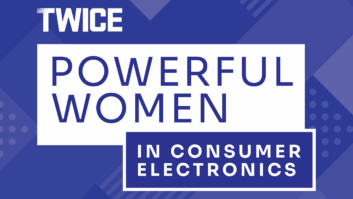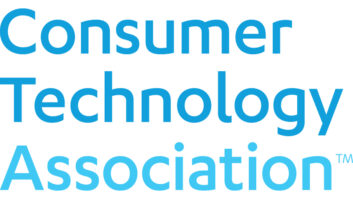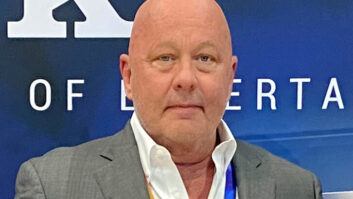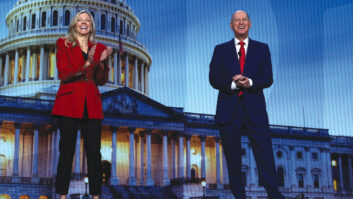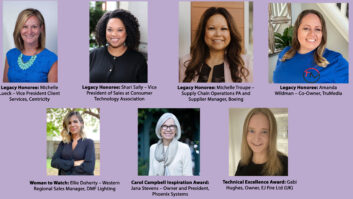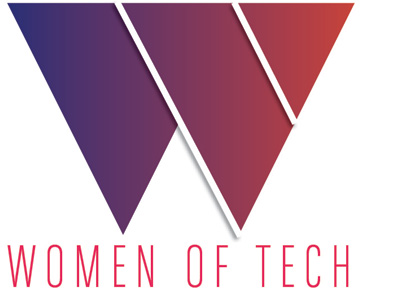
When TWICE first started talking about initiating the Women Of Tech advisory board, it didn’t seem there could be a more suitable year than now. As the publication of record for the industry, our staff is very familiar with the challenges women have faced in consumer electronics and technology, a grouping of traditionally male-dominated fields. We have also been well acquainted, often personally, with the many industry members working to bring about change, and we want to shine the spotlight on these women, their efforts and their knowledge.
As part of this board, TWICE has asked esteemed members of our industry to join us in this initiative. Through an ongoing series of roundtables, columns and events, we will explore the role of women in technology — what it’s like to work in the industry and what’s moving the needle — and share valuable input about the buying power and habits of this demographic. We are kicking things off this issue with a virtual roundtable with five of our new members, and you can expect to see more perspectives and information from these women, and our other board members, in future issues. (Some of the other women joining this initiative include HSN’s Sandy Conrad, Thulium’s Tamara McCleary, and Alexis Palmer Zinberg of Palmer Advanced Media.)
Trying to craft a single experience, and thus a single outlook, of being a woman in technology is impossible; our participants have all taken individual paths and bring unique perspectives. What has been near-universal from these responses, however, is a positive outlook for the opportunities ahead, and an acknowledgement there’s more work to be done.
Here’s what they had to say:
From left: Karen Chupka, CES and corporate business strategy senior VP, Consumer Technology Association; Stephanie Dismore, VP and general manager, Americas channels, HP; Leigh Donadieu, senior product line manager, wet products, Electrolux; Jeannette Howe, membership director, BrandSource; Jodi Sally, product marketing director, Hisense USA

What are some of the current challenges and obstacles facing women employed in the technology and consumer electronics industry?
Leigh Donadieu, Electrolux: I was in London last month, and enjoyed the experience of being here the day Theresa May, the second female prime minister in U.K. history, assumed office. At home in the U.S., we are as close as we have ever yet come to a female winning the nomination as the Democratic candidate for president of The United States. {Editor’s note: These remarks were made prior to the Democratic National Convention and Hillary Clinton’s official nomination clinch.] These are exciting times for women in leadership positions.
That being said: In my experience, one of the greatest challenges to face women in our industry is status quo. It seems strange to say that at the same time as these historic changes are taking place, that our challenge is our own current state. The good news is that there are many initiatives, exciting initiatives like [this one] that are taking shape. These are becoming increasingly powerful vehicles that communicate the positive message of opportunity, and this is likely to challenge the status quo.
Jeannette Howe, BrandSource: The biggest challenge, at the end of the day, is being a woman. In this business arena we are few and far between. This is a guy’s guy industry and the inner circles, entertainment, perks, conversation, food and particularly the Tshirts (How many XL T-shirts can one gal have?) are largely for the benefit of the males. I have found the executive inner circle almost impossible to penetrate, and I have been in an executive position a number of times. In many respects, it is easier for men to “manage up” to their superiors and/or bosses because they have communally shared this locker room. As women, we are often allowed in the locker room, but we are not fully welcome to join in the general camaraderie.
Karen Chupka, CTA: There are great opportunities for women in the technology industry. I think the biggest obstacle is that women may not be fully aware of all of the opportunities and/or career options that are available within the tech space. I use that term loosely, because technology is now weaved into almost every aspect of our lives and tech roles are not limited to those with just engineering or programming expertise. Technology is now a driving force in many non-traditional tech industries like healthcare, fashion, sports, beauty, automotive and so much more. There is a need for creative, outside-of-the-box thinking when it comes to incorporating tech advances in these areas to both new and existing audiences.
Jodi Sally, Hisense: I wouldn’t say that our current challenges are related to gender at all. The industry has evolved, rapidly fueled by changes in consumer shopping behaviors (mobile and Internet) and how content-delivery and entertainment options have evolved from what used to be traditional hardware and optical disc formats to Internet-based entertainment options. These changes challenge all marketers to be more creative.
Stephanie Dismore, HP: Being a woman in tech represents an opportunity — not an obstacle. In an industry that is dominated by men, I think women often feel the need to try to “fit in” or “tough it out,” when, really, we should instead be asking ourselves, “How can I be myself?” Women stand out in our industry, which in itself provides us an opportunity to bring forth our unique and valuable perspectives.
How have things improved since you entered the field? Can you point to specific progress?
Donadieu: Since I began working in the consumer goods industry, there is a vastly improved awareness of the opportunities for development, growth and success. Examples of this progress include the Women In Business with chapters being championed by important organizations like the BrandSource buying group, and this one by TWICE. Awareness itself is a powerful force, probably one of the most powerful forces as a catalyst to effect real change.
Howe: More and more women’s groups are popping up. I work for BrandSource and Anitra Brase (our Global Leadership Unit Director) is championing BrandSource’s Women in Business (WiB) group. Back in 2009, Carol Campbell founded Women in Consumer Technology; InfoComm has a woman’s group. People are beginning to recognize that being a woman in this business can be isolating, alienating and lonely. When I first met Anitra, she was puzzling over how few women are in the appliance business. In comparison, CE is a barren landscape. When these groups of women come together, there is a palpable energy and female camaraderie. It is quite empowering and encouraging to meet and get to know other female professionals in this male-dominated industry. And, by the way, these groups are also supported by men. As far as specifics, we have certainly reduced the “Booth Babe” count at many of our industry shows.
Dismore: I think the IT industry in general is making great progress in narrowing the gender gap and promoting greater diversity. We’re seeing a lot more women in leadership positions at major tech companies, and we’re seeing a stronger pipeline for young women to pursue tech careers. I’m also in very good company at HP, where I have developed relationships with several other women leaders within the company.
Sally: If this question is specific to gender equality, overall, it is refreshing to see more female executives in the industry from when I first started in the industry in the late ’80s. Having first started my career for a large Japanese brand, it was, culturally, very rare for females to be in leadership roles back then. Thankfully, this has changed.
Chupka: I’ve been fortunate to have many opportunities in my career at CTA. I do see more women now in leadership roles and hope that gives females more confidence to try out different jobs and be open to opportunities for growth.
What are your thoughts on the idea of “having it all” — is this possible or just a buzzword? Is this a generational sentiment?
Donadieu: When the concept of “having it all” is applied as something unique to professional women, I’ll have to be honest here: It makes me want to roll my eyes and groan. I think it perpetuates aged stereotypes that women feel they have to be homemakers first, and professionals somewhere after that. Ugh. “Having it all” is something that should apply to everyone without reference to gender. It’s why people in general work at all, right? Quality of life, financial stability, etc.
Chupka: No one has it all. That is simply unachievable and unattainable. The faster you figure that out in life, the sooner you will achieve happiness.
Dismore: Something always has to give. You can’t be the best mom, the best daughter, the best friend, the best employee and the best leader all at once. Sometimes your family is going to need you more; sometimes work is going to take over. I believe that the key to making it work is managing expectations and communicating them often. I have learned that my kids are more understanding of my business demands if I set the right expectations: “I will be gone this week; however, I am dedicating my weekend to you!” It’s the same with business. I find that customers, partners and employees appreciate that family comes first sometimes and will be more supportive if I have to miss a meeting, etc., so long as the expectations have been set with them.
Howe: My persisting challenge over the many years I have spent in this industry has been life/work balance. “Having it all” is a myth. Women have to show up doubly more prepared than men; we can’t wear the same suit every day for a week, and we must be mindful of appearing aggressive or bossy. There may be only one of us with a seat at the boardroom table in a room full of men. No one really has it all; I haven’t met a man who “has it all” either.
Sally: The term “Having it all” could have different definitions for each individual. For me it means a good life/work balance and the feeling that you are making accomplishments each and every day. Personally, I’m very competitive with a relentless attitude to succeed; I don’t give up very easily.
What about the importance of mentoring? Is this something you strive (or intend) to do in your career? Did you have a mentor?
Donadieu: My thought is that I would love to have one! So far in my career, I have had a mentor, and I’m of a mind that it’s never too late for anyone to enjoy the benefits of learning from one’s role model. I have been asked to participate in a couple different programs as a mentor — for defined periods of time or specific projects — and I found the experience highly rewarding. Overall, I think this can be a very impactful thing for individuals at all stages of their career.
Howe: I have had a number of mentors. I have mentored others and even participated in a “co-mentoring” situation. In many cases, our friends and families don’t understand what we do for a living, so celebrating victories becomes difficult at home. I have had some huge “wins” in my professional life, and at times I have had no one to call! I feel very fortunate to have worked with some particularly strong women. At nearly every place I have worked I found a woman who has not only worked by my side, but also became a lifelong friend. The point being, it is a woman, one woman, not multiple women. At many of the companies for which I have worked, I was the only woman in an executive position.
Chupka: It’s important to have someone — or a group of trusted advisors — who can give honest feedback, including things you don’t necessarily want to hear. I’ve had many people (both male and female) who have given me open and honest advice and encouragement. Generally, I think women can do more to support each other.
Dismore: Mentoring is what you make of it. It can be extremely valuable in areas like personal development, networking, career-mapping advice, and even how to manage the complexities of having a family and fulfilling your career aspirations. The key in fostering a successful mentoring relationship is up to you; how you connect with your mentor, the cadence you establish, being prepared for the time, etc., is what will help make the mentoring relationship beneficial.
Sally: Whether or not we all realize it, we’ve all had mentors in our careers, so yes, mentoring is important and in my opinion continues throughout one’s career. Even though we’ve become more experienced, we’ll continue to learn from each other; listening with an open mind is important. For me, personally, I first realized the importance of mentoring when I was awarded a TWIN (Top Women In Industry) Award in 1999. Part of this recognition required me to speak to young females who were considering what career paths to choose. Having an influence on these young females and letting them know that they have the ability to choose their career directions, was very inspirational for me.
What are manufacturers and retailers getting right when it comes to marketing to women? And what are some things they’re getting wrong?
Chupka: I think they understand that design is important and that it’s not a one-size-fits-all approach.
Donadieu: The shift to digital-first strategies is something that manufacturers are getting right. Women are savvy consumers, and, more often than not, they are the purchase decision maker, especially in our industry. Women are also social-media savvy, and highly skilled at navigating the digital space for information as well as influence.
Howe: Women have the same appreciation for elegant and easy-to-use products as men. That said, I don’t put things in my pockets. It is hard to maintain a svelte figure when you live on airplanes and camp in hotels. Putting my cellphone in my pocket — if I even have a pocket — creates yet another bulge. There is a whole generation of women growing up right now who actually carry their phone in their hand. I watch women in the Apple store looking at the wall of iPhone cases and not seeing what they need. In fact, I have a friend who carries her phone in her bra (that’s not a good bulge on me either). The idea that pink or Swarovski crystals makes something useful for women is simply misguided.
Dismore: It’s not about marketing to women or men necessarily; it’s about creating marketing campaigns that engage consumers on an emotional level and demonstrate very clearly how the latest products/technologies can improve, enhance, enrich and simplify their lives.
Sally: The evolvement of digital marketing now requires marketers to capture a buyer’s attention much more quickly, succinctly and creatively. Reading customer reviews before making a purchase decision has become part of the shopping path; consumers are already armed with this info in the palm of their hands when they start their shopping. Above all, it’s important to have a quality product that the company feels confident standing behind. Then you must leverage creative marketing to help the product stand apart. We’ve undertaken a brand refresh at Hisense, taking into account our target audience and their needs and desires, and I’m very proud of the cool, creative, eye-catching work that has emerged. Together our quality product, creative advertising and smart brand sponsorships are helping us build awareness for a brand that is relatively new in the U.S., and we’re helping drive footsteps to our retail partners’ stores and websites.
Do you think there are opportunities for women’s-only product lines or in-store departments?
Howe: Entertainment, convenience and safety are not just for men. As an industry, we no longer sell to student hobbyists living in college towns or guys building man caves. The industry has grown up and there has been a greater focus on selling to families and using technology to stay connected. Home control, 5.1 immersive sound entertainment, security, and many of our high-tech solutions are gender agnostic. Additionally, as the boomers get older, technology will have a huge impact on “aging in place.”
Sally: This has already happened — just look at how fashion has become a product differentiator in CE categories like headphones and/or accessories. In large CE products such as televisions, women are already a large part of the purchasing decision. At the end of the day, it’s about understanding what your audience is looking for, be it women or men. Simplicity and ease of use have dictated changes in audio products, and we see this reflected in television purchase trends as well. And for all consumers, great designs and merchandising attract attention and differentiate products in a retail setting.
Dismore: I believe there is opportunity to create product lines and departments focused on and targeted for women; however, I don’t think that’s the headline. The winning story is not “women-only.” The power and success is in creating a message that connects and engages consumers in general on a more emotional level. This message starts with the product, but must be communicated through content, campaigns, merchandise, etc. We all need to do a better job at communicating how our products improve, enhance and simplify and enrich our lives.
Chupka: Maybe, but only if it addresses a specific need that differs from the general product. For instance, about 20 years ago someone gave my mother a toolkit made for women. It was a small case that had basic tools. The tools all had smaller grips that were more comfortable for a woman’s hand. This seemed genius to me because it was designed to be lightweight and keep all of the tools in place. The tools were easier to use because they were made for a smaller grip. This would not have worked had the kit included all normal sized tools, but come in pink or another girly color just so that it could be marketed to women.
How can manufacturers tailor their marketing and advertising to make their message better resonate with women?
Donadieu: I think that a marketing message designed to capture of the interest of — and communicate to — an informed consumer is what makes sense.
Sally: Keep it simple, eye-catching and truthful.
Chupka: Woman are the same as men on this one, everyone needs to understand where the value is. For me it’s making it easy for me to understand what a product or service does and why I need it.
Dismore: The message delivered in all marketing and advertising campaigns is critical. The consumerization of IT is a reality; we must be relevant to all consumer lifestyles by bridging the gap between technology, family, sports, fashion, beauty, work, etc.
Howe: Sometimes it is the little things that count. For example, I love that many restaurants and bars are providing hooks on which to hang a purse. I used to drop my purse on the kitchen counter until I realized that putting my purse on the kitchen counter is akin to putting my street shoes on the kitchen counter. That purse sits on restaurant and bathroom floors and it spends way too much time “under the seat in front of me.” Products that appeal to men and women bridge the gap. I cannot think of an Apple ad that was directly speaking to either sex, but its messaging surely resonates with a lot of people.
All said, I wouldn’t trade my professional career for any other. I love this crazy business, the friends (mostly male) I have made and the lessons I have learned along the way. I remember a friend saying, “I don’t go to my high school and college reunions. I go to CEDIA. That’s where my friends are.”






